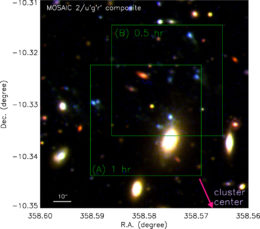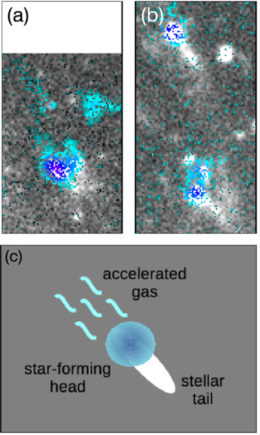
MUSE fields of view (1′ × 1′ for each square) are superimposed on a pseudo-color image of the elliptical galaxy in Abell 2670. The blue blobs lie in the opposite direction to the galactic center. [Sheen et al. 2017]
Unexpected Jellyfish
We often see galaxies that have been disrupted or reshaped due to their motion within a cluster — but these are usually late-type galaxies like our own. Such gas-rich galaxies are distorted by ram pressure as they fall into the cluster center, growing long tails of stripped gas and young stars that earn them the name “jellyfish galaxies”.
But early-type, elliptical galaxies have long since used up or cleared out most of their gas, and they correspondingly form very few new stars. It’s therefore unsurprising that they’ve never before been spotted to have jellyfish-like features.

Panels a and b show zoomed-in observations of some of the star-forming blobs with tadpole-like morphology. Panel c shows a schematic illustration of how ram-pressure stripping causes this shape. [Adapted from Sheen et al. 2017]
Tadpole Blobs
These observations reveal a number of features, including starbursts at the galactic center, 80-parsec-long tails of ionized gas, disturbed halo features, and several blue star-forming blobs with tadpole-like morphology in the surrounding region. The blobs have stellar tails that point in the direction of motion of the galaxy (toward the cluster center) and streams of ionized gas that point in the opposite direction.
All of these features are signs that this galaxy is being ram-pressure stripped as it falls into the center of the cluster. The star-forming blobs, for example, are exhibiting classic ram-pressure-stripping behavior: as a galaxy falls into the cluster center, streams of ionized gas blow downwind, and stars (which don’t respond as easily to the force of the wind) are left behind in a stream pointing upwind.
Gas from a Merger?

An example of a tidal tail drawn out from a disrupted late-type galaxy. The disrupted galaxy in Abell 2670 is, in contrast, an early-type, elliptical galaxy that should be gas-poor. [H. Ford, JHU/M. Clampin, STScI/G. Hartig, STScI/G. Illingworth, UCO, Lick/ACS Science Team/ESA/NASA]
The authors therefore speculate that the galaxy recently underwent a “wet merger” — a merger with a companion galaxy that was gas-rich. Much of this gas was driven to the center of the elliptical galaxy in the merger, and it’s now responsible for the starbursts there.
We’ll hopefully be able to draw stronger conclusions about this unusual galaxy after additional investigation into the amount of gas it contains and the galaxy’s star formation rate. In the meantime, this stripped elliptical makes for an intriguing puzzle!
Citation
Yun-Kyeong Sheen et al 2017 ApJL 840 L7. doi:10.3847/2041-8213/aa6d79


9 Comments
Pingback: Una elíptica con gas en Abell 2670. | Pablo Della Paolera
Pingback: Tadpole elliptical galaxy
Pingback: Curious Case of a Stripped Elliptical Galaxy – New
Pingback: El curioso caso de una galaxia elíptica despojada – Observatori Astronòmic
Pingback: Mayo 2017 – Observatori Astronòmic
Pingback: Galaxia despojada « SEDA / LIADA - RedLIADA - Cursos LIADA - Cielo del Mes - Fenómenos Astronómicos - RELEA
Pingback: Galaxia elíptica despojada « Sección de Astrofísica
Pingback: An enigmatic jellyfish elliptical galaxy – LABNAUT
Pingback: An enigmatic jellyfish elliptical galaxy – Bel Dumé